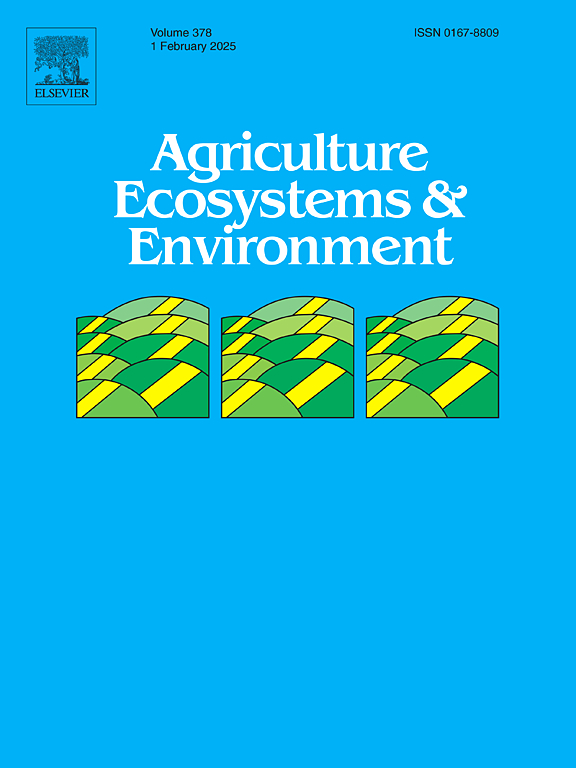Grazing overrides precipitation reduction to regulate growth of a dominant species in a typical steppe
IF 6
1区 农林科学
Q1 AGRICULTURE, MULTIDISCIPLINARY
引用次数: 0
Abstract
Overgrazing and drought are critical drivers of grassland degradation, yet their combined impacts on plant growth and succession, especially the dominant species, are still poorly understood, making it difficult to develop the sustainable pasture management. We conducted a three-year field experiment (2019–2021) on China’s Loess Plateau to assess the intricate impacts of grazing management (NG – no grazing, CG – cassation of grazing, and HG – grazing with high intensity) and precipitation reduction (R0 – no precipitation reduction, R30 – 30 % precipitation reduction, and R60 – 60 % precipitation reduction) on the growth and reproduction of Artemisia capillaris, a dominant species in the semi-arid grassland ecosystem. Our results show that HG significantly decreased plant height, crown width, reproductive branches, and aboveground biomass. CG only facilitated partial recovery of these traits, suggesting a prolonging grazing cassation is essential for ecosystem restoration after a long period of overgrazing. A. capillaris exhibited a preference for asexual reproduction, with potential trade-offs between sexual and asexual modes in response to varying environmental conditions. Precipitation reduction primarily affected vertical growth, with cumulative effects observed after three years (i.e., in 2021). Compared to precipitation reduction, grazing imposed a more substantial negative impact on aboveground biomass, indicating the need for optimum grazing strategies in grassland management. The findings underscore the importance of considering dominant species and highlight the long-term consequences of overgrazing that must be incorporated into sustainable grassland management practices in semi-arid regions. The study delivers insights into pasture management science, and addresses that grazing cessation may be an appropriate method of grassland management, mitigating the negative effects of prolonged overgrazing and precipitation reduction on the growth and reproduction of dominant species in semi-arid regions.
在典型草原上,放牧超越降水减少来调节优势物种的生长
过度放牧和干旱是草地退化的重要驱动因素,但它们对植物生长和演替的综合影响,特别是对优势物种的影响尚不清楚,这给草场的可持续管理带来了困难。通过2019-2021年为期3年的黄土高原野外试验,研究了放牧管理(NG -不放牧、CG -放养和HG -高强度放牧)和降水减少(R0 -不降水、R30 - 30% %降水和R60 - 60% %降水)对半干旱草地生态系统优势种毛蒿生长和繁殖的复杂影响。结果表明,汞处理显著降低了植物株高、冠宽、生殖枝和地上生物量。CG只促进了这些特征的部分恢复,这表明在长期过度放牧后,延长放牧期对生态系统恢复至关重要。毛毛瓢虫表现出对无性繁殖的偏好,在不同的环境条件下,可能在有性和无性繁殖模式之间进行权衡。降水减少主要影响垂直生长,3年后(即2021年)观测到累积效应。与降水减少相比,放牧对地上生物量的负面影响更为显著,表明在草地管理中需要优化放牧策略。研究结果强调了考虑优势物种的重要性,并强调了过度放牧的长期后果,必须将其纳入半干旱地区的可持续草地管理实践。该研究为草地管理科学提供了新的见解,并提出了停牧可能是一种适当的草地管理方法,可以减轻半干旱区长期过度放牧和降水减少对优势物种生长和繁殖的负面影响。
本文章由计算机程序翻译,如有差异,请以英文原文为准。
求助全文
约1分钟内获得全文
求助全文
来源期刊

Agriculture, Ecosystems & Environment
环境科学-环境科学
CiteScore
11.70
自引率
9.10%
发文量
392
审稿时长
26 days
期刊介绍:
Agriculture, Ecosystems and Environment publishes scientific articles dealing with the interface between agroecosystems and the natural environment, specifically how agriculture influences the environment and how changes in that environment impact agroecosystems. Preference is given to papers from experimental and observational research at the field, system or landscape level, from studies that enhance our understanding of processes using data-based biophysical modelling, and papers that bridge scientific disciplines and integrate knowledge. All papers should be placed in an international or wide comparative context.
 求助内容:
求助内容: 应助结果提醒方式:
应助结果提醒方式:


